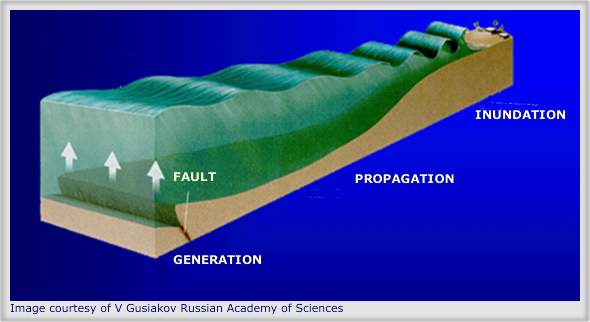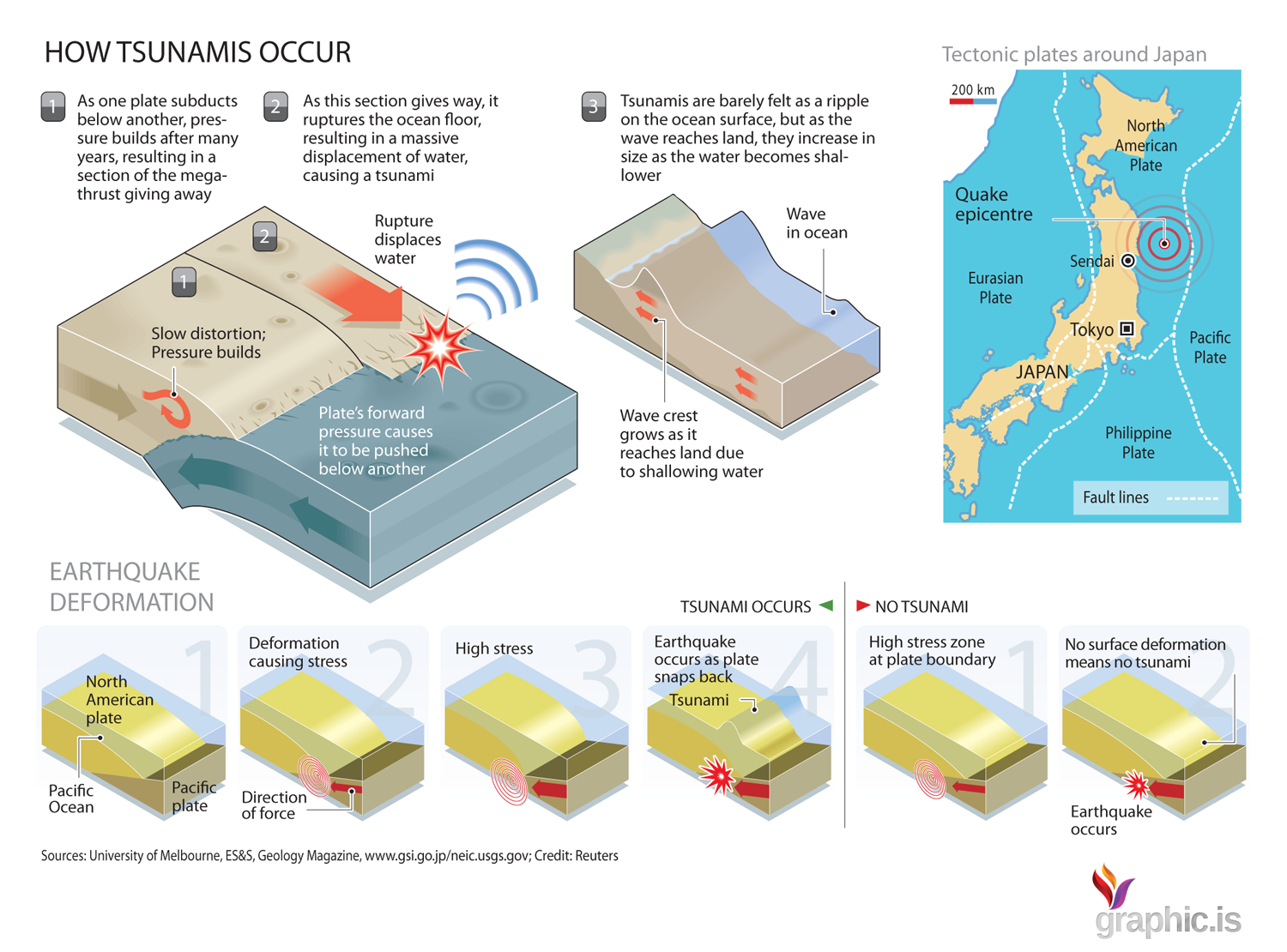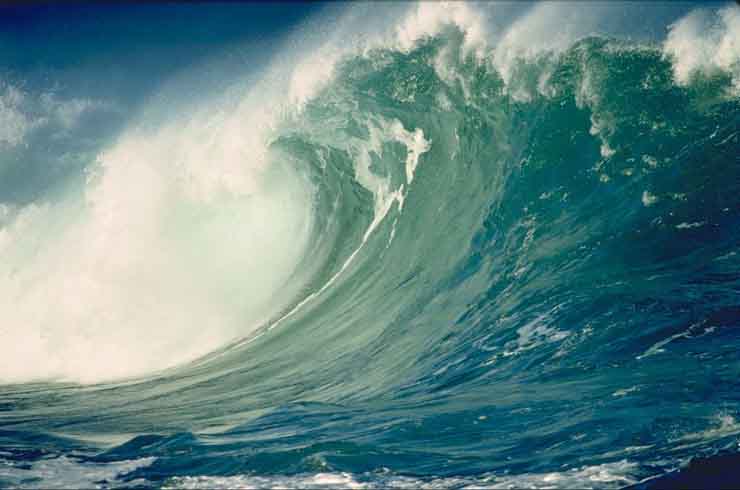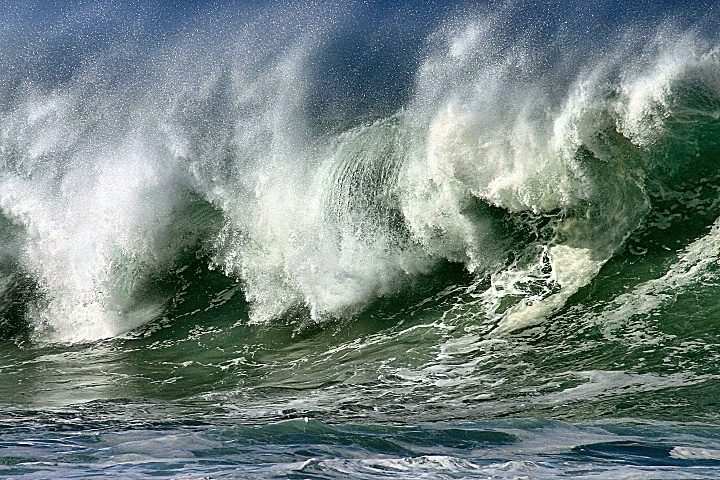|
What are Tsunamis?
A tsunami is a series of waves, generated in a body of water by an impulsive disturbance that vertically displaces the water column. Earthquakes, landslides, volcanic eruptions, explosions, and even the impact of cosmic bodies, such as meteorites, can generate tsunamis. Tsunamis can savagely attack coastlines, causing devastating property damage and loss of life. |
 |
How does a tsunami occur?
As a tsunami leaves the deep water of the open ocean and travels into the shallower water near the coast, it transforms. A tsunami travels at a speed that is related to the water depth - hence, as the water depth decreases, the tsunami slows. The tsunami's energy flux, which is dependent on both its wave speed and wave height, remains nearly constant. Consequently, as the tsunami's speed diminishes as it travels into shallower water, its height grows. Because of this shoaling effect, a tsunami, imperceptible at sea, may grow to be several meters or more in height near the coast. When it finally reaches the coast, a tsunami may appear as a rapidly rising or falling tide, a series of breaking waves, or even a bore.
As a tsunami approaches shore, it begins to slow and grow in height. Just like other water waves, tsunamis begin to lose energy as they rush onshore - part of the wave energy is reflected offshore, while the shoreward-propagating wave energy is dissipated through bottom friction and turbulence. Despite these losses, tsunamis still reach the coast with tremendous amounts of energy. Tsunamis have great erosional potential, stripping beaches of sand that may have taken years to accumulate and undermining trees and other coastal vegetation. Capable of inundating, or flooding, hundreds of meters inland past the typical high-water level, the fast-moving water associated with the inundating tsunami can crush homes and other coastal structures. Tsunamis may reach a maximum vertical height onshore above sea level, often called a runup height, of 10, 20, and even 30 meters. |
 |
Safety first for tsunamis
If you are on land:
 |
If you are in school and you hear there is a tsunami warning, you should follow the advice of teachers and other school personnel. |
 |
If you are at home and hear there is a tsunami warning, you should make sure your entire family is aware of the warning. Your family should evacuate your house if you live in a tsunami evacuation zone. Move in an orderly, calm and safe manner to the evacuation site or to any safe place outside your evacuation zone. Follow the advice of local emergency and law enforcement authorities. |
 |
If you are at the beach or near the ocean and you feel the earth shake, move immediately to higher ground, DO NOT wait for a tsunami warning to be announced. Stay away from rivers and streams that lead to the ocean as you would stay away from the beach and ocean if there is a tsunami. |
 |
Tsunamis generated in distant locations will generally give people enough time to move to higher ground. For locally-generated tsunamis, where you might feel the ground shake, you may only have a few minutes to move to higher ground. |
 |
High, multi-story, reinforced concrete hotels are located in many low-lying coastal areas. The upper floors of these hotels can provide a safe place to find refuge should there be a tsunami warning and you cannot move quickly inland to higher ground. Local Civil Defense procedures may, however, not allow this type of evacuation in your area. Homes and small buildings located in low-lying coastal areas are not designed to withstand tsunami impacts. Do not stay in these structures should there be a tsunami warning. |
 |
Offshore reefs and shallow areas may help break the force of tsunami waves, but large and dangerous wave can still be a threat to coastal residents in these areas. Staying away from all low-lying areas is the safest advice when there is a tsunami warning. |
If you are on a boat:
 |
Keep in contact with the authorities should a forced movement of vessel be directed. |
 |
If you are aware there is a tsunami warning and you have time to move your vessel to deep water, then you may want to do so in an orderly manner, in consideration of other vessels. Owners of small boats may find it safest to leave their boat at the pier and physically move to higher ground, particularly in the event of a locally-generated tsunami. Concurrent severe weather conditions (rough seas outside of safe harbor) could present a greater hazardous situation to small boats, so physically moving yourself to higher ground may be the only option. |
 |
Damaging wave activity and unpredictable currents can effect harbors for a period of time following the initial tsunami impact on the coast. Contact the harbor authority before returning to port making sure to verify that conditions in the harbor are safe for navigation and berthing. |
|
 |
 |
|
|
